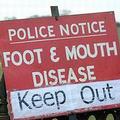 美國國家安全部建議,將國家生物及農業防衛研發所(National Bio and Agro-Defense Facility)設立在曼哈頓的堪薩斯州立大學。這個單位主要在研究會影響家畜的外來動物和傳染病,特別是人畜共通傳染病。
美國國家安全部建議,將國家生物及農業防衛研發所(National Bio and Agro-Defense Facility)設立在曼哈頓的堪薩斯州立大學。這個單位主要在研究會影響家畜的外來動物和傳染病,特別是人畜共通傳染病。
美國獸醫學會(AVMA)代表超過7萬6千名在公私立醫院、政府機關、業界、學界和聯邦單位工作的獸醫,也支持這項聯邦法案。
12月初發佈的環境影響總結綱要報告(FEIS)分析6個候選興建地點的潛在風險,分別是喬治亞州的雅典城、堪薩斯州的曼哈頓、密西西比州的麥迪遜縣、北卡的格蘭維爾縣、德州的聖安東尼和紐約州的梅島。
報告書指出,堪薩斯的優勢包括鄰近研究區域,人才不虞,包括堪薩斯州立獸醫學院、農業學院和生物安全研究院。
國家生物及農業防衛研發所對堪薩斯市周遭密集的動物健康公司也有幫助,最近一個新構想便是將該區發展為堪薩斯市的動物健康走廊。
國家安全部的科學科技組12月初發佈研發所的環境影響總結綱要報告(FEIS),預定2009年1月12日正式公佈。研發所的設計從今年展開,明年開始興建,預計2015年之前展開運作。
這個新單位將會用於研究人畜共通的病毒傳染病,包括如下所列之疾病:
口蹄疫:畜養和野生偶蹄動物的病毒急性傳染病,病徵是發燒、跛瘸、口足舌頭和乳頭出現水泡,口蹄疫被認為是最嚴重的傳染病之一,倘若在美國爆發,估計將損失370億美金。
豬瘟:野生和畜養豬是目前已知的自然宿主,高度的致病性使其蔓延全球,在尚未爆發疫情的國家隨時可能出現一波極嚴重的流行。豬瘟爆發不僅對國內和國際間的豬肉和豬肉製品貿易都會有嚴重影響,還需研擬更完善的因應措施。
非洲豬瘟:是一種高死亡率的傳染病,目前仍缺乏有效的應對措施或疫苗足以預防或治療。
裂谷熱:感染人和偶蹄動物(包括綿羊、山羊、牛、駱駝、水牛和鹿)的病毒性傳染病,美國還沒有適當的應對措施。有局部爆發的風險,美國農業部、國家安全部和其他相關單位認為裂谷熱值得高度關注。
牛肺疫(傳染性牛胸膜炎):是由一種多形性菌(Mycoplasma mycoides)傳染,主要感染牛,包括歐洲牛和瘤牛(Zebu),沒有治療方式。可感染山羊的是相似的另一種菌。
日本腦炎:和聖路易腦炎病毒相似,日本腦炎病毒可在畜養豬和野生鳥的血液中繁殖,病毒可感染人、大部分畜養動物、鳥、蝙蝠、蛇和青蛙。
立百病毒:生物安全第四級的病毒,1999年被發現。透過接觸傳染,可感染人類與豬隻,但傳染機制仍未釐清,只知道需要接觸感染部位或體液。在新加坡和馬來西亞造成呼吸道和腦炎,目前仍缺乏藥物和其他治療方式,也沒有應對措施。
亨德拉病毒:生物安全第四級的病毒,先前被稱作馬痲疹病毒,1994年被分離出來。目前還不清楚亨德拉病毒有哪些自然宿主,只知道馬和人類是主要感染對象,澳洲爆發疫情時,病徵包括神經和呼吸道症狀。
更多資訊請參考這裡。
The Department of Homeland Security is recommending Kansas State University in Manhattan as the site of the National Bio and Agro-Defense Facility for the study of foreign animal and zoonotic diseases that can affect livestock. Zoonotic diseases are those caused by infectious agents that can be transmitted between animals and humans.
The American Veterinary Medical Association, representing more than 76,000 veterinarians working in private and corporate practice, government, industry, academia, and uniformed services, is backing federal legislation to establish the facility.
Released earlier this month, the final environmental impact statement, or FEIS, analyzes the potential risks of building the National Bio and Agro-Defense Facility at six possible locations: Athens, Georgia; Manhattan, Kansas; Madison County, Mississippi; Granville County, North Carolina; San Antonio, Texas; and Plum Island, New York.
The FEIS lists the strengths of the Kansas site as including proximity to existing research capabilities and workforce, notably at Kansas State's veterinary college, agriculture college, and Biosecurity Research Institute.
The National Bio and Agro-Defense Facility also could be beneficial to the animal health companies that have clustered in an area around Kansas City. A recent initiative has promoted the region as the Kansas City Animal Health Corridor.
In early December, Homeland Security's Science and Technology Directorate released the final environmental impact statement for the National Bio and Agro-Defense Facility. The directorate will publish a formal record of decision on January 12, 2009. Facility design is expected to begin this year, with construction to begin in 2010. Plans call for the facility to be operational by 2015.
The new facility will provide the environment suitable for study of virulent diseases that can be transferred from animals to humans such as:
- Foot and Mouth Disease: Viral disease of domestic and wild cloven-hoofed animals; acute disease characterized by fever, lameness, and vesicular lesions on the feet, tongue, mouth and teats; FMD is considered to be one of the most contagious, infectious diseases known; cost estimates of an introduction of FMD in the U.S. are more than $37 billion.
- Classical Swine Fever: Wild and domestic swine are the only known natural reservoir; widespread throughout the world and has the potential to cause devastating epidemics, particularly in countries free of the disease; any outbreak of CSF would have serious consequences for domestic and international trade of swine and swine products; improved countermeasures are needed.
- African Swine Fever: Infected animals have high mortality rates; effective countermeasures are not available for infected animals; no vaccines are available to prevent infection; no treatment exists for ASF and countermeasures need improvements.
- Rift Valley Fever: Virus affects human beings and cloven-hoofed animals (sheep, goats, cattle, camels, buffalo and deer); suitable countermeasures to respond in the U.S. do not exist; risk for establishment of endemic disease; ranked as a major disease of concern with USDA, DHS, and other stakeholders.
- Contagious Bovine Pleuropneumonia: Caused by an infective microorganism (Mycoplasma mycoides); primarily affects cattle including European-bred cattle and Zebu; a related form can affect goats; may survive for days in the environment; no treatment available.
- Japanese Encephalitis Virus: Similar to St. Louis encephalitis virus; JE virus is amplified in the blood of domestic pigs and wild birds; the virus can infect humans, most domestic animals, birds, bats, snakes and frogs.
- Nipah Virus - Biosecurity Level 4: Virus was discovered in 1999; causes disease in swine and in humans through contact with infectious animals; mode of transmission between animals and from animals to humans is uncertain (appears to require close contact with infected tissues or body fluids); caused respiratory disease and encephalitis in people in Malaysia and Singapore; no drug therapies have yet been proven to be effective in treating Nipah infection; no countermeasures exist.
- Hendra Virus - Biosecurity Level 4: Formerly called equine morbillivirus; first isolated in 1994; the natural reservoir for Hendra virus is still under investigation; human beings and equines seem to be predominately affected; caused respiratory and neurological disease in horses and humans in Australia.
For more about the National Bio and Agro-Defense Facility click here.




